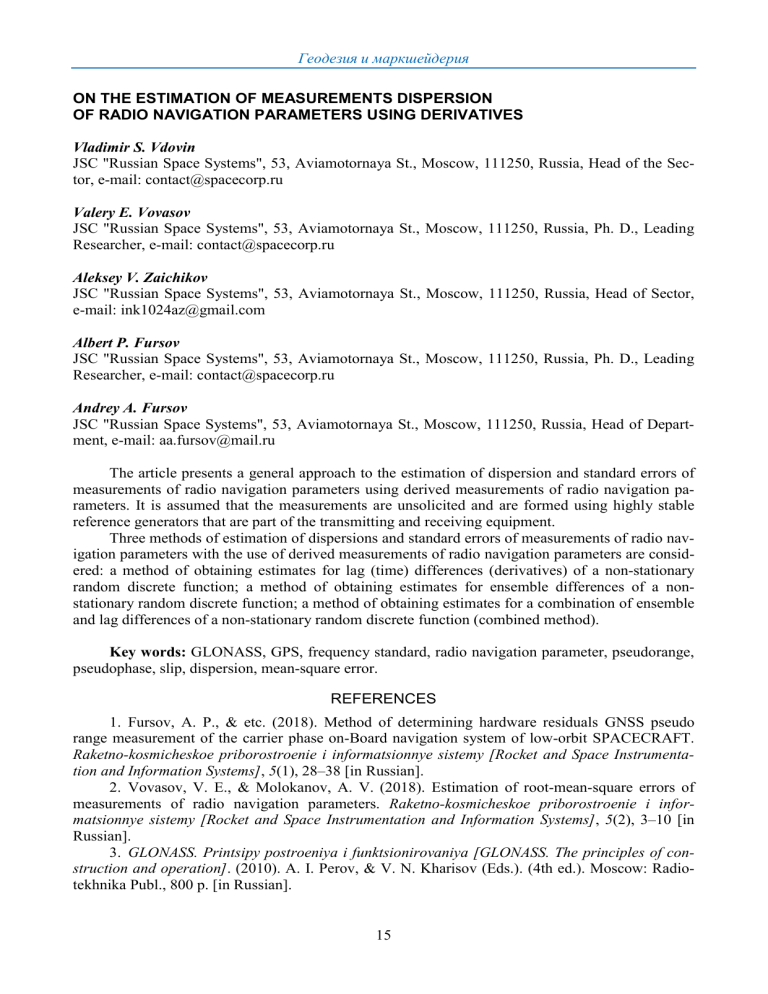
Геодезия и маркшейдерия
ON THE ESTIMATION OF MEASUREMENTS DISPERSION
OF RADIO NAVIGATION PARAMETERS USING DERIVATIVES
Vladimir S. Vdovin
JSC "Russian Space Systems", 53, Aviamotornaya St., Moscow, 111250, Russia, Head of the Sector, e-mail: contact@spacecorp.ru
Valery E. Vovasov
JSC "Russian Space Systems", 53, Aviamotornaya St., Moscow, 111250, Russia, Ph. D., Leading
Researcher, e-mail: contact@spacecorp.ru
Aleksey V. Zaichikov
JSC "Russian Space Systems", 53, Aviamotornaya St., Moscow, 111250, Russia, Head of Sector,
e-mail: ink1024az@gmail.com
Albert P. Fursov
JSC "Russian Space Systems", 53, Aviamotornaya St., Moscow, 111250, Russia, Ph. D., Leading
Researcher, e-mail: contact@spacecorp.ru
Andrey A. Fursov
JSC "Russian Space Systems", 53, Aviamotornaya St., Moscow, 111250, Russia, Head of Department, e-mail: aa.fursov@mail.ru
The article presents a general approach to the estimation of dispersion and standard errors of
measurements of radio navigation parameters using derived measurements of radio navigation parameters. It is assumed that the measurements are unsolicited and are formed using highly stable
reference generators that are part of the transmitting and receiving equipment.
Three methods of estimation of dispersions and standard errors of measurements of radio navigation parameters with the use of derived measurements of radio navigation parameters are considered: a method of obtaining estimates for lag (time) differences (derivatives) of a non-stationary
random discrete function; a method of obtaining estimates for ensemble differences of a nonstationary random discrete function; a method of obtaining estimates for a combination of ensemble
and lag differences of a non-stationary random discrete function (combined method).
Key words: GLONASS, GPS, frequency standard, radio navigation parameter, pseudorange,
pseudophase, slip, dispersion, mean-square error.
REFERENCES
1. Fursov, A. P., & etc. (2018). Method of determining hardware residuals GNSS pseudo
range measurement of the carrier phase on-Board navigation system of low-orbit SPACECRAFT.
Raketno-kosmicheskoe priborostroenie i informatsionnye sistemy [Rocket and Space Instrumentation and Information Systems], 5(1), 28–38 [in Russian].
2. Vovasov, V. E., & Molokanov, A. V. (2018). Estimation of root-mean-square errors of
measurements of radio navigation parameters. Raketno-kosmicheskoe priborostroenie i informatsionnye sistemy [Rocket and Space Instrumentation and Information Systems], 5(2), 3–10 [in
Russian].
3. GLONASS. Printsipy postroeniya i funktsionirovaniya [GLONASS. The principles of construction and operation]. (2010). A. I. Perov, & V. N. Kharisov (Eds.). (4th ed.). Moscow: Radiotekhnika Publ., 800 p. [in Russian].
15
Вестник СГУГиТ, Том 24, № 3, 2019
4. Povalyaev, A. A. (2008). Sputnikovye radionavigatsionnye sistemy: vremya, pokazaniya
chasov, formirovanie izmereniy i opredelenie otnositel'nykh koordinat [Satellite radio navigation
systems: time, clock readings, formation of measurements and determination of relative coordinates]. Moscow: Radiotekhnika Publ., 328 p. [in Russian].
5. Povalyaev, A. A., Weizel, V. A., & Mazepa, R. B. (2012). Global'nye sputnikovye sistemy
sinkhronizatsii i upravleniya v okolozemnom prostranstve [Global satellite systems of synchronization and control in near-earth space]. A. A. Povalyaev (Ed.). Moscow: University Book Publ., 188
p. [in Russian].
6. Statisticheskaya teoriya radiotekhnicheskikh system [Statistical theory of radio engineering systems]. (2003). Moscow: Radiotekhnika Publ., 400 p. [in Russian].
7. Weizel, V. A. (Ed.). (2005). Radiosistemy upravleniyaradio [Control systems]. Moscow:
Drofa Publ., 415 p. [in Russian].
8. Vovasov, V. E., & Irkaev, N. B. (2014). The method of determining the hardware signal
delay for a dual frequency receiver of the SRNS GLONASS. Raketno-kosmicheskoe priborostroenie i informatsionnye sistemy [Rocket and Space Instrumentation and Information Systems],
1(2), 25–32 [in Russian].
9. Zhdanyuk, B. F. (1978). Osnovy statisticheskoy obrabotki traektornykh izmereniy [Fundamentals of statistical processing of trajectory measurements]. Moscow: Sov. Radio Publ., 384 p.
[in Russian].
10. Tyapkin, B. N., & Garin, E. N. (2012). Metody opredeleniya navigatsionnykh parametrov
podvizhnykh sredstv s ispol'zovaniem sputnikovoy radionavigatsionnoy sistemy GLONASS [Methods for determining the navigation parameters of mobile vehicles using satellite radio navigation
system GLONASS]. Krasnoyarsk: SFU Publ., 260 p. [in Russian].
11. Antonovich, K. M. (2005). Ispol'zovanie sputnikovykh radionavigatsionnykh sistem v geodezii [The use of satellite radio navigation systems in geodesy]. Moscow: FGUP "Bartgeier" Publ.,
334 p. [in Russian].
12. Ventzel, E. S. (1968). Teoriya veroyatnostey [Probability theory]. Moscow: Nauka Publ.,
576 p. [in Russian].
13. Romanovsky, V. I. (1947). Primeneniya matematicheskoy statistiki v opytnom dele [Applications of mathematical statistics in the experimental case]. Moscow: OGIZ Publ., 247 p.
[in Russian].
14. Bronstein, I. N., & Semendyaev, K. A. (1986). Spravochnik po matematike dlya inzhenerov i uchashchikhsya vuzov [Handbook of mathematics for engineers and students of higher education institutions]. Moscow: Nauka Publ. [in Russian].
15. IS-GPS-800E.25-APR-2018. NAVSTAR GPS Space Segment/User Segment L1C Interface. Retrieved from https://www.gps.gov/technical/icwg/IS-GPS-800E.pdf.
16. Standarts Russian Federation. (2004). GOST R 50779.21-2004. Statistical technology.
Rules of definition and methods of calculation of statistical characteristics on sample data. Part 1.
Normal distribution. Retrieved from ConsultantPlus online database [in Russian].
17. Time series Analysis. (n. d.). Retrieved from http://reshebniki-online.ru/node/34414/
[in Russian].
Received 02.04.2019
© V. S. Vdovin, V. E. Vovasov, A. V. Zaychikov,
A. A. Fursov, A. P. Fursov, 2019
16
